Content Marketing Strategy: The Role Your Company Blog Plays in Conversions
There are many reasons to invest (at least) a portion of your total marketing budget in content creation and distribution. After all, publishing valuable content allows businesses to reach many different goals. These objectives include boosting brand and product awareness, driving organic website traffic, improving customer engagement, or maximizing customer retention. It’s also worth mentioning that those who are prepared to combine content production with SEO have an increased chance to win top positions on SERPs, which guarantees multiple measurable benefits when working to grow a business .
But if you look at the research about content marketing, you’ll see that most marketers aren’t investing in content to drive organic traffic to their websites. They’re doing so to improve sales . In fact, a recent report from HubSpot revealed that more than 60% of brands measure content marketing success through sales .
So what does this mean? It’s relatively simple. The finding shows that when looking to improve website conversion rates, it’s not a bad idea to explore ways to employ your company blog to reach your objectives.
If you’re ready to upgrade your content strategy with conversion-improving tricks, the following are the best ways to use your company blog to increase sales.
Include a Strong CTA on Evergreen Posts
Whether you’re just getting started with content distribution or have been doing it for years, it’s safe to say that the most valuable type of post you can publish is one that has the potential to become evergreen.
Evergreen content stands out amongst any other type of format for two reasons:
- It gives your audience generous amounts of value that do not fade over time.
- Thanks to a long-form structure and keyword optimization, evergreen content has the potential to generate impressive website traffic. (In fact, research shows that long-form articles get 77.2% more backlinks and 56.1% more social shares than posts that are shorter than 1,000 words.)
But here’s the thing. Neither of these benefits matters if you’re not doing enough to turn organic website visits into sales . And it just so happens that the best way to accomplish that specific goal is to use a powerful call to action on pages that attract a large number of web visitors.
It’s worth noting that the things that make a CTA strong will differ from business to business.
For example, on a page like MarketBeat’s US Stock Market Holidays , a banner inviting web visitors to “Save $200 today” aligns with the audience’s intention of making money.
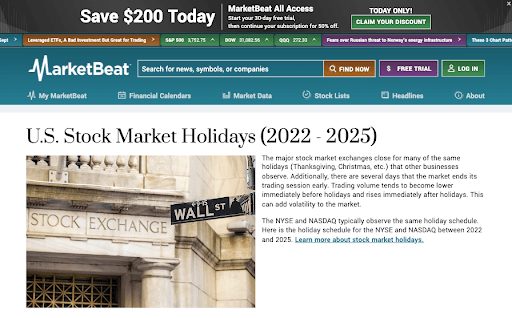
Source: marketbeat.com
However, a lifestyle business like MasterClass will get better results by capitalizing on its instructors’ authority. This is why on a design-related blog post , CTA sections invite prospects to “Learn from the best” and highlight that users can build photography and design-related skills by learning from superstars like Annie Leibovitz, Frank Gehry, and Dian von Furstenberg.

Source: masterclass.com
So, to enhance your content pages with impactful calls to action, ensure that you identify your audience’s pain points. Then, use phrases that will address those wants and offer a solution that people would be happy to try out.
Promote Your Other Marketing Channels
Did you know that, on average, it takes about eight touches to make a sale ? That’s right. To turn a prospect into a customer, they must interact with your brand at least eight times (or more, if you’re a B2B organization).
Now, this process is not something you can rush. After all, aggressive sales tactics usually backfire, which is why you should not encourage a first-time website visitor to invest in your $5,000 solution. However, you can optimize your company blog to encourage people to continue interacting with your brand so that you can gradually nurture them into buyers.
Using CTAs that direct reader attention towards alternative marketing channels (like your social media accounts or your newsletter), you can effectively turn people populating the top stages of the sales funnel into viable leads.
For example, January AI’s Best Snacks for Diabetics post shows how effectively this brand uses TOFU content to get people interested in metabolic health insights. That’s why the most prominent CTA on this page includes an invitation to sign up for the brand’s newsletter, which promises valuable content and allows the business to use a more intimate format (like email) to turn blog readers into app users.

Source: january.ai
Alternatively, you could also promote your social media channels. For example, Figma did it with their What’s new in Figma blog post, which calls user attention to the fact that the most detailed company news get published on the brand’s Twitter profile.

Source: figma.com
Build a Subject Matter Authority
Generating trust is one of the prerequisites for an impressive conversion rate. But whom do consumers trust nowadays?
Research from Edelman revealed that the most trustworthy brand ambassadors include scientists and experts and that the content most likely to get them to trust an influencer is educational content.
In other words, when it comes to content meant to boost sales, investing in subject matter authority equals conversions .
With this in mind, one of the most valuable things you can do on your company blog is to publish posts that show you know what you’re talking about — especially when targetting people in the consideration phase of the buyer’s journey.
Explore ways to prove authority through content. For example, companies like Transparent Labs do this by using scientific references and providing extensive details on a subject. Moreover, if you look at the brand’s guide to creatine supplements , you’ll see that it prioritizes value over making a sale and even includes information about the author’s credentials.
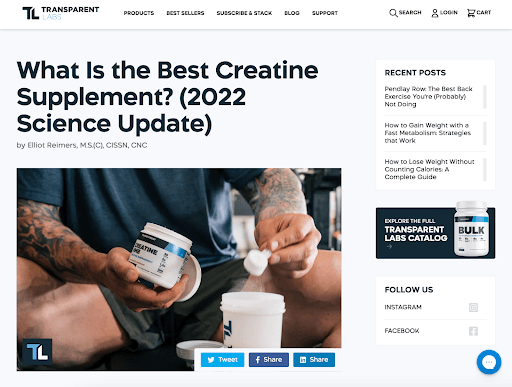
Source: transparentlabs.com
Of course, there are other ways to boost subject matter authority while increasing conversion rates. Lead magnets, such as the Ultimate Site Audit ebook by Semrush , are also excellent ways to prove your brand’s trustworthiness. They provide users with valuable information, all the while encouraging their movement down the sales funnel.
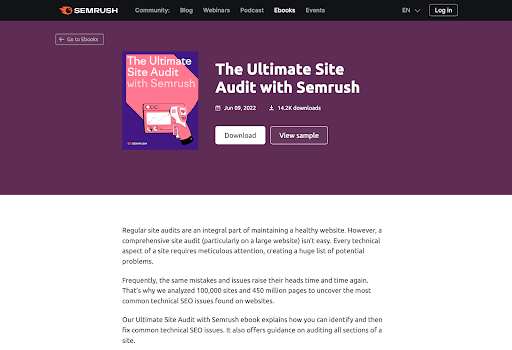
Source: semrush.com
Help Customers Get the Most out of Your Product
In some cases, the best way to use your company blog isn’t to aid customer acquisition but to boost customer retention instead. After all, by extending customer lifetime value, you’re not just injecting funds into your company budget. Even more, you’re maximizing the ROI on your active marketing campaigns and building a more predictable cash flow you can rely on in the future.
And the best thing about using content to do this? It’s easy, cost-effective, and relies on the knowledge and experience you already have.
By creating tutorials and how-to posts that help customers get the most out of your product, you’re actively helping them get more value from their purchase, maximizing their satisfaction, and increasing their chances of becoming brand ambassadors. This is particularly beneficial for businesses that offer highly-technical products that have complex features which require a steep learning curve.
For instance, if you check out Affinda’s How to Use Invoice Recognition Software guide, you’ll see how effectively this post answers a specific customer question. By taking inspiration from it — creating screenshots and writing accessible copy — you can accomplish the same thing on your blog, maximizing your customers’ satisfaction and boosting CLV at the same time.

Source: affinda.com
Create Conversion-Focused Content
Although it may seem obvious, creating conversion-focused content is a crucial part of publishing posts that boost sales. After all, the highest likelihood of converting a customer is if they’re in the Decision stage of the buyer’s journey and you present them with information that directly impacts their purchase decision .
To master this strategy, start by becoming familiar with content formats meant for the bottom of the sales funnel. These include product reviews, demos, customer testimonials, spec sheets, etc.
A quick look at EachNight’s best mattresses guide shows a great example of a piece of content meant to serve the bottom of the sales funnel. It provides objective product information, includes high-impact CTAs (which are logically placed to encourage readers to shop for the items), and even contains special offers that allow leads to get more value for their money.
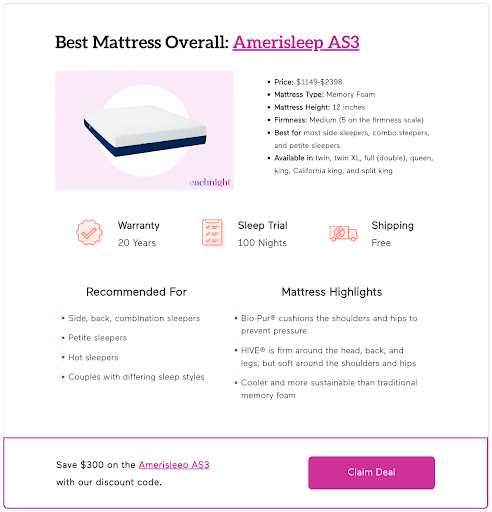
Source: eachnight.com
Of course, knowing that you’re targeting people at the bottom of the sales funnel (who need that extra push to convert), it might not be a bad idea to turn your social proof into blog posts .
For instance, you can get inspired by Slack and publish case studies , which show prospects specific ways you solved customer pain points and gives them a good idea of what they can expect from our solution, along with an incentive to get in touch with your sales team.
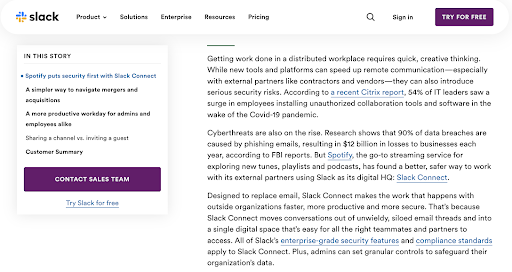
Source: slack.com
Highlight Your Product’s Relevance
Lastly, as you explore content formats that will help you boost conversion rates, consider different ways to prove that your organization has its customers’ best interests at heart .
Blog posts that delve into what your product does and elaborate on unique features that solve highly specific pain points are excellent tools when trying to inspire sales.
A look at the Flamingo Product Updates article shows how effectively we illustrate our dedication to customer satisfaction. Highlighting our product team’s customer-first mindset is often the push potential buyers need to take the first step towards conversion.
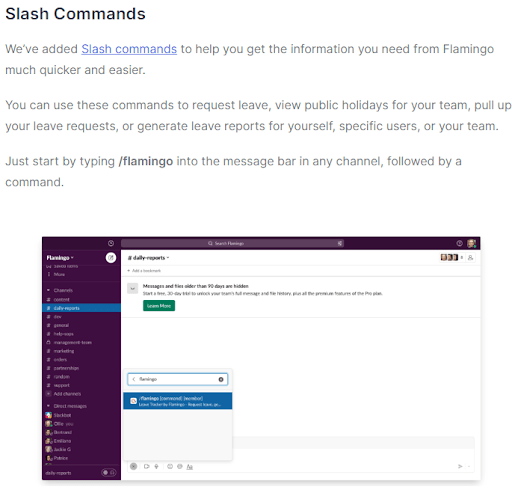
Source: helloflamingo.com
Alternatively, you might look up to Therabody, a high-authority brand that regularly teams up with other industry leaders to provide its audience with new and exciting findings and prove that its solutions work. For instance, in an announcement stating that it’s teaming up with Oura , Therabody establishes its credibility when it comes to promoting sports recovery. It further proves its dedication to customer experience and helping its (current and future) customers to maximize their recovery and performance.
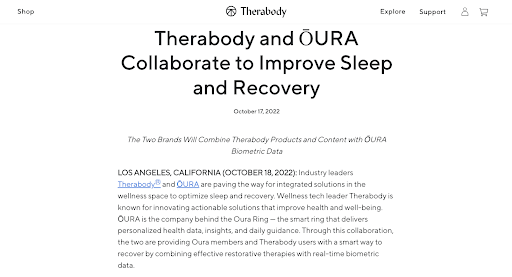
Source: therabody.com
In Closing
Investing in high-quality content is always a great idea.
But as you explore strategies that will help you transform standard blog posts into powerful conversion-driving assets, don’t forget to start the production process by defining two things:
- your objectives
- your target audience’s position in the sales funnel
Once you know precisely what you want to accomplish and what stage of the buyer’s journey your prospects are in, you can optimize your blog posts to solve your prospects’ pain points, give them valuable information that will help them make a purchasing decision, and encourage them to turn into loyal customers of your brand.
The post Content Marketing Strategy: The Role Your Company Blog Plays in Conversions appeared first on Olive Street Design.



















